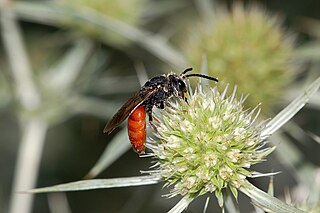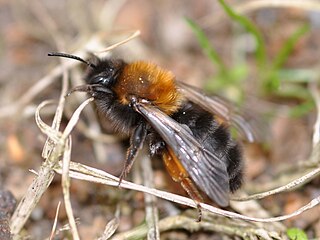
Sphecodes albilabris is a solitary parasitic bee that is endemic to Central and Western Europe. It also occurs in North Africa and is thought to have been introduced to the United States and Australia by accident.

Osmia cornuta, the European orchard bee, is a species of bee in the genus Osmia.

Andrena hattorfiana is a species of mining bees belonging to the family Andrenidae subfamily Andreninae.

Amegilla quadrifasciata, the white-banded digger bee, is a species of bee belonging to the family Apidae subfamily Apinae.

The hairy-footed flower bee is a species of bee belonging to the family Apidae.

Anthidium oblongatum, the oblong woolcarder bee, is a species of bee in the family Megachilidae, the leaf-cutter, carder, or mason bees. It is native to Eurasia and north Africa, and has also been introduced to North America.

Osmia latreillei is a species of mason bee belonging to the family Megachilidae subfamily Megachilinae.

Anthophora dispar is a species of bee belonging to the family Apidae subfamily Apinae tribus Anthophorini.

Mutilla europaea, the large velvet ant, is a species of parasitoid wasps belonging to the family Mutillidae. It is a parasitoid on various species of bumblebees and is found in Europe, Asia, and North Africa.

Coelioxys, common name leaf-cutting cuckoo bees or sharp-tailed bees, is a genus of solitary kleptoparasitic cuckoo bees belonging to the family Megachilidae.

The Clark's miner bee is a species of miner bee in the family Andrenidae. Other common names include Clark's andrena and Clarke's mining bee. It is found in Europe and Northern Asia and North America.

Hylaeus communis is a Palearctic species of solitary bee.

Osmia aurulenta is a Palearctic species of mason bee.

Tetralonia malvae, also known as the Mallow longhorn, is a species of insect belonging to the family Apidae. The bee takes pollen from oligolectic sources on the mallow family (Malvaceae).

Bombus semenoviellus is a species of insect belonging to the family Apidae.

Camptopoeum friesei is a species of bees of the genus Camptopoeum.

Anthophora bimaculata is a species of bee.

Pseudoanthidium tenellum is a species of bee in the family Megachilidae.

Tetraloniella dentata is a species of bees within the genus Tetraloniella.



















